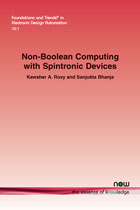Non-Boolean Computing with Spintronic Devices
By Kawsher A. Roxy, University of South Florida, USA, kawsher@mail.usf.edu | Sanjukta Bhanja, University of South Florida, USA, Bhanja@usf.edu
Abstract
In addition to the electron’s charge, Spintronics deals with the electron’s spin and magnetic moment for computation or data storage. Certainly, an extremely promising application of spintronic devices is datastorage; the remanence makes the memory non-volatile and instant-on. Moreover, these devices are thermally stable making them suitable for extreme-temperature operations. In this monograph, we leverage spintronic devices for information processing and do not cover data-storage. We explore three non- Boolean computational framework: (1) Energy minimization based optimizer, which we recently published in Nature Nanotechnology [23], (2) Coupled Oscillatory framework [47] and (3) Neuromorphic learning framework. In Energy minimization framework, we harness the innate physical properties of nanomagnets to directly solve a class of energy minimization problems. Due to the fact that the Hamiltonian of a system of coupled nanomagnets is quadratic, a wide class of quadratic energy minimization can be solved much more quickly by the relaxation of a grid of nanomagnets than by a conventional Boolean processor. Another property that researchers have harnessed is achieving radio-frequency ferromagnetic resonance, which can be harnessed in a system of nano-oscillators to provide solution to dynamical systems. This property is also utilized in neuromorphic frameworks.
Non-Boolean Computing with Spintronic Devices
One of the most promising emerging non-volatile memories is magnetic tunnel junction (MTJ); this is a Spintronic element where electronic charge and spin are both used for storing and manipulating digital information. Indeed, many companies have proposed this as a universal memory targeting embedded RAM, DRAM, and storage class memory domains primarily due to features like non-volatility, ultra-low power consumption, high endurance, rad-hardness, etc. However, the increasingly popular data-centric approach for solving non-Boolean problems, often called in memory computing, may also benefit by exploiting this kind of device.
Non-Boolean Computing with Spintronic Devices explores the latest research areas that employ spintronic devices for non-Boolean computing purposes. Due to the physical limits of traditional computing frameworks, researchers have focused on unconventional solving paradigms like neural networks, associative memory, neuromorphic computing, etc. This monograph also illustrates a novel mechanism to solve computationally expensive binary quadratic optimization problems via an energy minimization framework of nanomagnets. This hardware platform opens the possibility of achieving energy efficient processors such as the Ising model and Bayesian inference co-processor. However, the technology readiness level of spintronic devices is still maturing, so the research on the computing frameworks based on these devices is not static, rather dynamic. This monograph surveys the research to date and is an ideal reference for anyone interested in how the field is developing.
